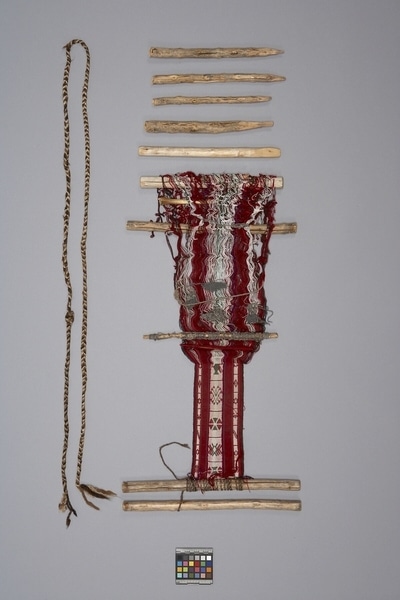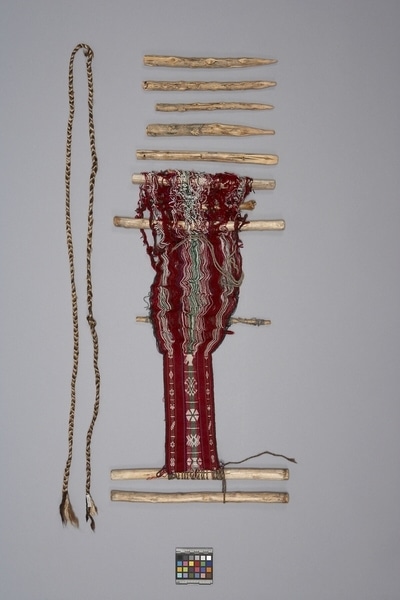Loom Item Number: Sf924 a-j from the MOA: University of British Columbia


Description
A loom (parts a-j) with an unfinished woven belt. The design consists of three white patterned bands with red and green figurative and geometric motifs all on a red ground. The textile is attached at the top and bottom to cylindrical shaped wooden sticks (part a). Intertwined in the multicoloured warp are two cylindrical shaped heddles; one covered in red twine, the other in brown. There are also two cylindrical shaped wooden tools (parts b and c); five cylindrical shaped wooden tools with a pointed end (parts d,e,f,g,h), all of varying size; one bone pick (part i) and a black and brown braided rope (part j).
History Of Use
Warp-faced fabrics with three or four selvedges are woven by women but the fabrics, the techniques, structures and some of the motifs have pre-Conquest antecedents. This type of textile conveys the most information about an individual's ethnicity, sex, age, status and particular history. The women weave near the house compound, particularly during July and August, between the seasons for harvesting and planting. They weave for themselves, for their families and for sale to tourists.
Narrative
Prepared for the Museum collection by Candelaria Cruz Machaca. The belt is of the size that would be used by a boy in his early teens.
Iconographic Meaning
The range of motifs refers to local geography and landmarks, ecology, fecundity as well as luck. The six part circle refers to the division of land into six sections on Taquile and the rotation of crops and fallow periods.
Specific Techniques
Weave structures are the following: 1- plain colour areas- warp faced plain weave. 2-figurative designs; complementary-warp weave with 3-span floats aligned in alternate pairs with an irregular (abbabaab) warping order (3/1 horizontal colour changes and diagonals of 2-span floats).
Cultural Context
women's weaving
Item History
- Made by Candelaria Cruz Machaca (Maker) in Taquile, Puno, Peru during 1982
- Collected by Mary Frame during 1982
- Owned by Mary Frame before February 10, 1983
- Received from Mary Frame (Seller) and Museum of Anthropology Shop Volunteers (Funding source) on February 10, 1983
What
- Name
- Loom
- Identification Number
- Sf924 a-j
- Type of Item
- loom
- Material
- synthetic, wool fibre, wood and dye
- Manufacturing Technique
- woven, retwisted, braided, whittled, plied and spun
- Part A
- height 69.6 cm, width 38.8 cm
- Part B
- height 38.7 cm, diameter 2.0 cm
- Part C
- height 36.9 cm, diameter 2.0 cm
- Part D
- height 30.8 cm, width 2.4 cm, depth 2.2 cm
- Part E
- height 28.3 cm, diameter 2.5 cm
- Part F
- height 25.9 cm, diameter 1.4 cm
- Part G
- height 19.1 cm, diameter 1.6 cm
- Part H
- height 29.3 cm, diameter 1.9 cm
- Part I
- height 15.3 cm, width 2.4 cm, depth 2.2 cm
- Part J
- height 212.6 cm, width 3.3 cm
Who
- Culture
- Quechua
- Creator
- Candelaria Cruz Machaca (Maker)
- Field Collector
- Mary Frame
- Previous Owner
- Mary Frame
- Received from
- Mary Frame (Seller) and Museum of Anthropology Shop Volunteers (Funding source)
Where
- Holding Institution
- MOA: University of British Columbia
- Made in
- Taquile, Puno, Peru
When
- Creation Date
- during 1982
- Collection Date
- during 1982
- Ownership Date
- before February 10, 1983
- Acquisition Date
- on February 10, 1983
Other
- Item Classes
- textiles
- Condition
- good
- Accession Number
- 0861/0030 a-j